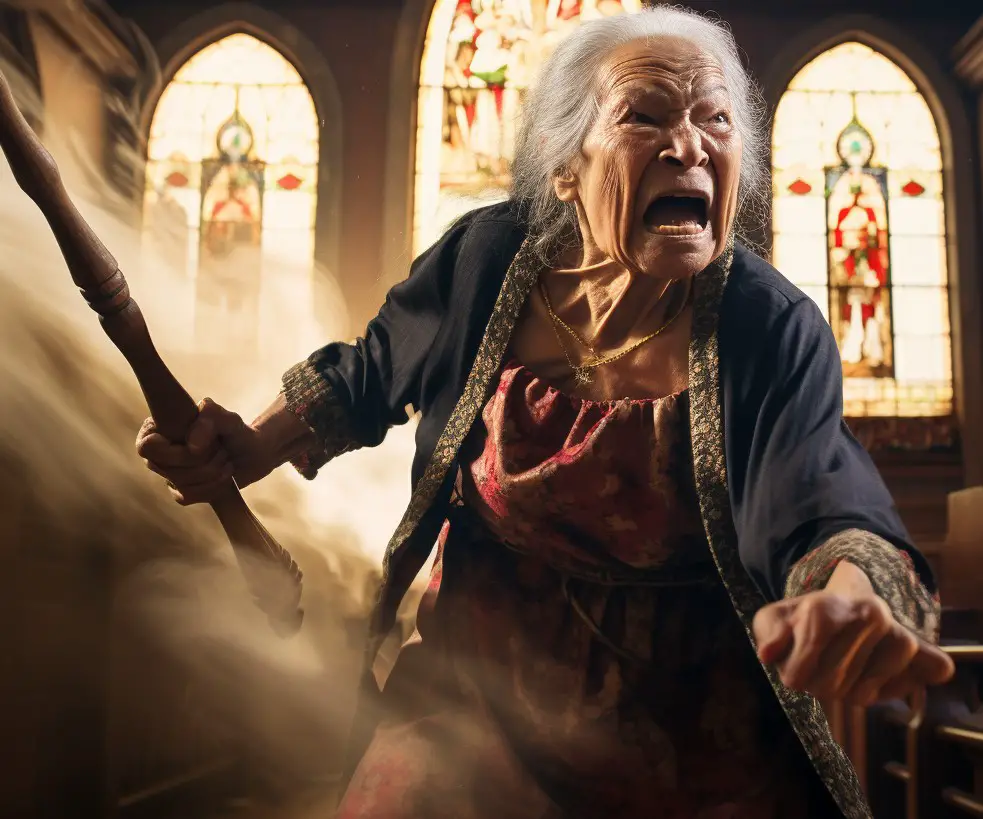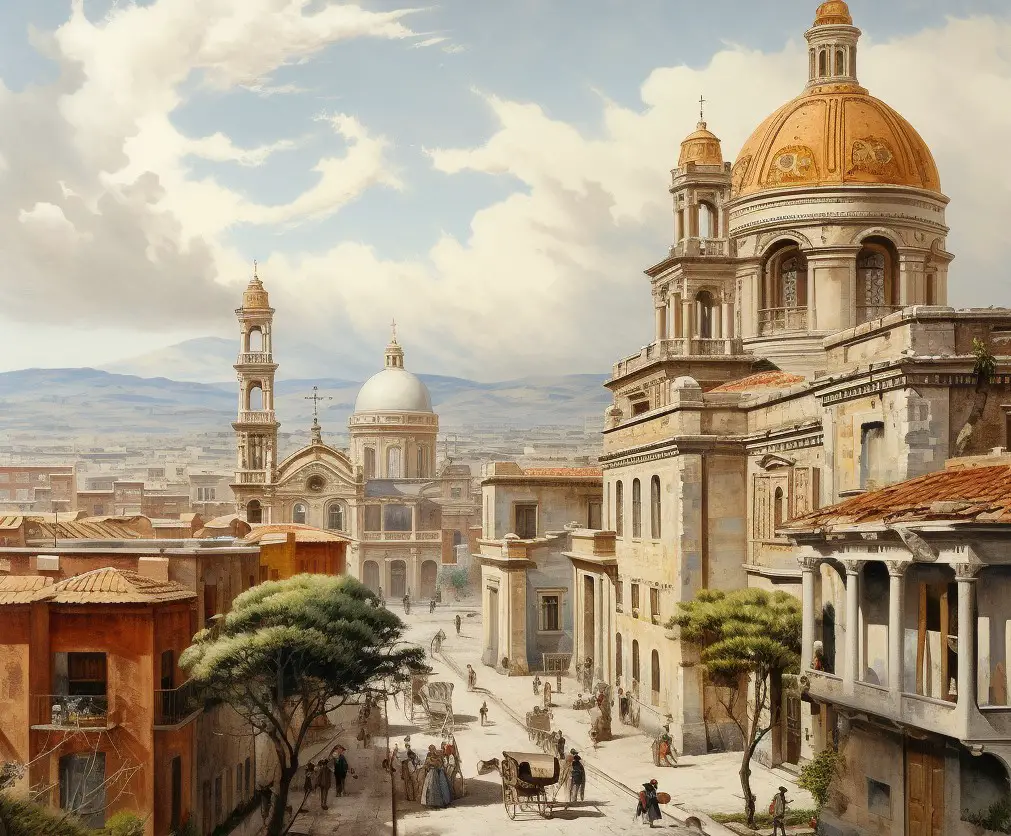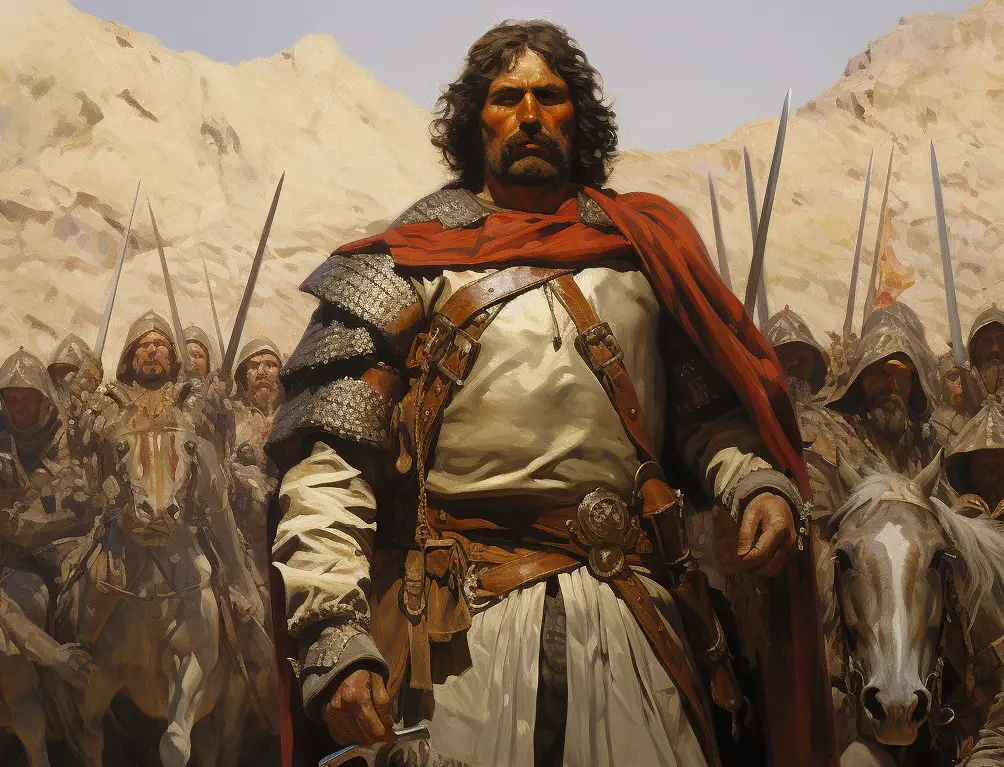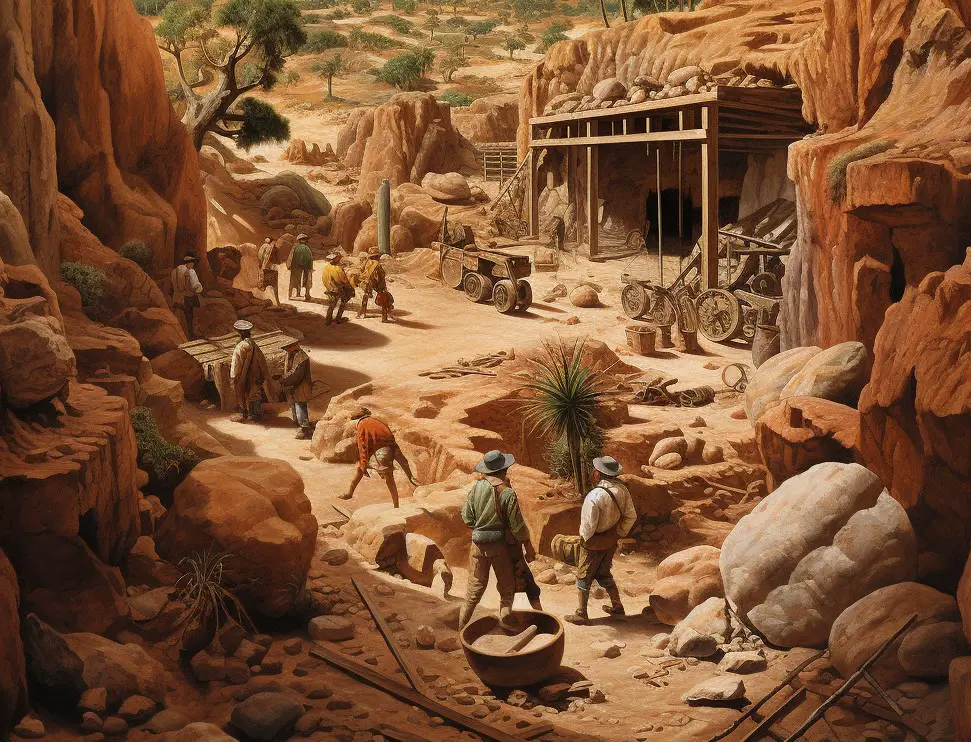Podcast: Play in new window | Download
Subscribe: Apple Podcasts | RSS
 The date was July 19, 1599. The northern frontier town of San Luis Potosí was humming with news of a trial. The day before, an indigenous woman who was well into her sixties had entered churches in the Tlaxcalan and Tarascan barrios of the town and according to court documents, “broke the crosses and removed all the images in them, stirring up all the Indians.” Several people from the congregations of those churches went to the local Justicia Mayor, the representative of the king’s justice in that far flung province, a man named Capitan Gabriel Ortiz de Fuenmayor. The Capitan saw the political importance of the woman’s actions through how those natives described what they did to their churches. They were more afraid of her powers as a witch than concerned about their houses of worship being desecrated. When Fuenmayor asked questions about the woman, he heard stories of how she threatened other natives, how she used her powers for ill and how she wanted supernatural forces to assist her and the rest of the local indigenous population in ousting the Spanish from their lands for good. After hearing enough about this problematic old woman, Fuenmayor decided to conduct a trial during which he would call witnesses, present evidence and hear testimony from the accused. To this day we do not know her name because she was not baptized a Christian and no formal name appears in any of the court documents. What is known in obscure history circles as “The Case of the Chichimec Witch” or “The Trial of the Guachichil Witch” was a very important turning point in the history of the northern frontier of New Spain and is still relevant over 400 years later.
The date was July 19, 1599. The northern frontier town of San Luis Potosí was humming with news of a trial. The day before, an indigenous woman who was well into her sixties had entered churches in the Tlaxcalan and Tarascan barrios of the town and according to court documents, “broke the crosses and removed all the images in them, stirring up all the Indians.” Several people from the congregations of those churches went to the local Justicia Mayor, the representative of the king’s justice in that far flung province, a man named Capitan Gabriel Ortiz de Fuenmayor. The Capitan saw the political importance of the woman’s actions through how those natives described what they did to their churches. They were more afraid of her powers as a witch than concerned about their houses of worship being desecrated. When Fuenmayor asked questions about the woman, he heard stories of how she threatened other natives, how she used her powers for ill and how she wanted supernatural forces to assist her and the rest of the local indigenous population in ousting the Spanish from their lands for good. After hearing enough about this problematic old woman, Fuenmayor decided to conduct a trial during which he would call witnesses, present evidence and hear testimony from the accused. To this day we do not know her name because she was not baptized a Christian and no formal name appears in any of the court documents. What is known in obscure history circles as “The Case of the Chichimec Witch” or “The Trial of the Guachichil Witch” was a very important turning point in the history of the northern frontier of New Spain and is still relevant over 400 years later.
When silver was discovered in Zacatecas in 1546, the future “Guachichil Witch” was just a little girl who was seeing her world change around her. After the discovery of silver, a mass influx of Europeans – along with African slaves and Christianized natives from central Mexico – began pouring into the northern regions of what is now the nation of Mexico. The land was occupied by what  he central Mexicans had called the “Chichimeca,” which was a loose term for the warlike and nomadic tribes that lived in the northern mountains and deserts and had blocked Aztec expansion into the area before the Spanish Conquest. For a general background of the Chichimec people, please see Mexico Unexplained episode 142: https://mexicounexplained.com/chichimeca-warriors-of-the-north/ The Chichimec groups called the Zacatecos and Guachichiles proved the most troublesome to the Spanish mining operations and to the ranchers and farmers who established themselves on the northern frontier to support the growing populations of the towns that grew up alongside the mines. After decades of outright war, the Spanish decided to use a carrot instead of a stick and gave the Zacatecos and Guachachiles gifts of food and manufactured goods to get them dependent enough on these luxuries so that they would give up their warring, nomadic existence and settle down. By the time of the famous witch trial of 1599, most of the Chichimec groups around the northern silver mines had been Christianized and had given up their old ways. Those who wished to continue their traditional ways of life were either pushed out to the margins away from European civilization, or they engaged in sporadic raiding from remote mountain or desert hideaways. There were people like the supposed “Chichimec Witch” who were straddling two worlds, living in settlements or near settlements but still having the mentality, sympathies and memories of a bygone age. Those people were of particular concern to the Spanish authorities because within them were the seeds of dissent and possible revolt.
he central Mexicans had called the “Chichimeca,” which was a loose term for the warlike and nomadic tribes that lived in the northern mountains and deserts and had blocked Aztec expansion into the area before the Spanish Conquest. For a general background of the Chichimec people, please see Mexico Unexplained episode 142: https://mexicounexplained.com/chichimeca-warriors-of-the-north/ The Chichimec groups called the Zacatecos and Guachichiles proved the most troublesome to the Spanish mining operations and to the ranchers and farmers who established themselves on the northern frontier to support the growing populations of the towns that grew up alongside the mines. After decades of outright war, the Spanish decided to use a carrot instead of a stick and gave the Zacatecos and Guachachiles gifts of food and manufactured goods to get them dependent enough on these luxuries so that they would give up their warring, nomadic existence and settle down. By the time of the famous witch trial of 1599, most of the Chichimec groups around the northern silver mines had been Christianized and had given up their old ways. Those who wished to continue their traditional ways of life were either pushed out to the margins away from European civilization, or they engaged in sporadic raiding from remote mountain or desert hideaways. There were people like the supposed “Chichimec Witch” who were straddling two worlds, living in settlements or near settlements but still having the mentality, sympathies and memories of a bygone age. Those people were of particular concern to the Spanish authorities because within them were the seeds of dissent and possible revolt.
Part of the Spanish Chichimec pacification process was to bring Christianized natives from central Mexico north in hopes that their “civilized” example would further encourage the Chichimeca to  give up their traditional way of life. The Spanish hoped that the more nomadic Indians would be watered down out of existence through intermarriage with indigenous people from central Mexico brought north. The Spanish were committing an error that many people still commit to this day, that is, thinking that all indigenous people are the same. The Tarascan or Purépecha people and the Tlaxcalans or Tlaxcalteca people, who were coming from the advanced civilizations in the south, had always looked down on the Chichimeca as barbarians. They had nothing in common with them and wanted very little to do with these people. And while some intermarriage did occur, it was extremely rare. In the town of San Luis Potosí the Tarascans and Tlaxcalans had their respective barrios and even they did not mix with each other. Among the Tlaxcalans themselves they had their own internal divisions in their San Luis Potosi barrio according to the social structures that were in place back home in Tlaxcala.
give up their traditional way of life. The Spanish hoped that the more nomadic Indians would be watered down out of existence through intermarriage with indigenous people from central Mexico brought north. The Spanish were committing an error that many people still commit to this day, that is, thinking that all indigenous people are the same. The Tarascan or Purépecha people and the Tlaxcalans or Tlaxcalteca people, who were coming from the advanced civilizations in the south, had always looked down on the Chichimeca as barbarians. They had nothing in common with them and wanted very little to do with these people. And while some intermarriage did occur, it was extremely rare. In the town of San Luis Potosí the Tarascans and Tlaxcalans had their respective barrios and even they did not mix with each other. Among the Tlaxcalans themselves they had their own internal divisions in their San Luis Potosi barrio according to the social structures that were in place back home in Tlaxcala.
Enter the old woman with a name lost to history who wanted to change all that. She had the radical idea that the only way to get rid of the Spanish was to put their differences aside and unite against these destructive invaders. For years she had been seen as a local rabble rouser, but her destruction of the interiors of the churches is what put her firmly in the crosshairs of the Spanish authorities. Guachichiles in the town of San Luis Potosi referred to the woman as an hechicera which is Spanish for “sorceress,” but this may have been only a close approximation of the term describing the role the woman played in her traditional society. Some researchers believe that the term the Guachichiles used to describe the woman would be more likened to “visionary” or someone who is in synch with and can command the natural forces around her. Whatever terms they used to describe her, witnesses were called, and a case was made against the woman later known as the Guachichil or Chichimec Witch.
 As this woman was not baptized a Christian, she was exempt from being examined under the Catholic Church’s Holy Inquisition. This rule goes back to the first encounters with the Spanish and the indigenous peoples of the New World. Under Church law, the people of the newly discovered lands were considered innocent if they had not yet received the proper religious instruction in the True Faith. Since this woman was not even baptized, the Inquisition had no case to try this old woman for witchcraft. So, the Spanish authorities set up a civil trial to deal with her, thus circumventing the Church’s authority in this case.
As this woman was not baptized a Christian, she was exempt from being examined under the Catholic Church’s Holy Inquisition. This rule goes back to the first encounters with the Spanish and the indigenous peoples of the New World. Under Church law, the people of the newly discovered lands were considered innocent if they had not yet received the proper religious instruction in the True Faith. Since this woman was not even baptized, the Inquisition had no case to try this old woman for witchcraft. So, the Spanish authorities set up a civil trial to deal with her, thus circumventing the Church’s authority in this case.
Of the 6 witnesses called in the trial, one was a Christianized Tarascan and 5 were from the same ethnic group as the woman, they were Guachichil. Only one of the Guachichil witnesses was baptized a Christian. The first witness called in the trial was Mateo, a Guachichil who lived in the Tlaxcala barrio. He saw the old woman destroy the interior of the Tlaxcalan church, but that wasn’t all. In his sworn testimony Mateo stated that the woman “yelled out in her native tongue that now many people would die, and that even if they saw her dead, they should not believe she had died, because many Indians and Christians would have to die before she died.” Mateo went on to tell the court that the same day the woman vandalized the church, she killed a Tarascan named Agustin by touching his ear with some sort of magic stick. In addition to this, Mateo stated that on Sunday, the old woman told all indigenous people not to go to mass, and out of fear of the woman’s powers, all regular churchgoers stayed home. While speaking to a crowd on that same day, according to Mateo the woman told the people there that the time would come where they would need to bring their sons and, “that no Spaniard was to be left alive, because all would be killed, because the Indians would kill them, and that they should all rise up, and that the earth would open with the sorcery that she was going to work.”
The second witness in the trial was a Tarascan named Juan and he corroborated the story of the first witness. He told of Agustin, the poor man whose ear was touched by the old woman and who went home, vomited violently, passed out and then died. Juan also mentioned in his testimony that the woman went to three other Indian settlements – San Miguel,
Agua del Venado, and Charcas – to try to get the men to go to the Tlaxcalan barrio of San Luis Potosi to rise up against the Spanish. She told them if they didn’t do as she asked, she would open up the earth and it would swallow them up.
The third witness was a Guachichil man named Juan who told of rumors that the old woman could turn herself into a coyote at will. Juan also witnessed the death of poor Agustin who was touched by the witch and further testified to the old woman traveling to various native settlements to try to sow the seeds of dissent under the threat of her using her own bag of magic tricks to make their lives miserable.
The fourth witness was an unbaptized Guachichil man named Gaspar who dazzled the court with stories of the old woman’s sorcery. Gaspar claimed to have known the woman for many years and during that time she bragged about how she had turned a man into a deer and how she turned her own partner, a man named Andrés, into a coyote. Gaspar also told the court that the woman had approached a former Chichimec war leader who had settled down after he was baptized and encouraged him to attack San Luis Potosi with a group of ex-warriors. When this Christianized Chichimec leader refused, the old woman threatened to open up the earth once again.
The fifth witness was Andrés, the old woman’s companion. He stated under oath that he had only known her for three years and they were friends, not husband and wife. He claimed that she once turned him into a coyote with her magical powers, and that she also turned her own son into a deer. Andrés claimed that the woman had both the intention and the power to make all dead indigenous people rise again to fight against the Spanish.
The last witness was Pedro de Torres, the captain of the Guachichiles in San Miguel. He said he was visited by the witch although he didn’t know her, and she wanted him to take part in an uprising. He reaffirmed his Christian faith to her, at which point the old woman fell to her knees and started pounding the dirt with her fists. This Guachichil leader, who was in good graces with the Spanish, told the court that the old woman had been traveling the countryside trying to unite people of various tribes, and promised them eternal life if they were to lose their lives in the fight. To the justice present, this was the key point made by a respected native leader that would be the nail in the coffin to seal the old woman’s fate.
 When called to give her testimony, the old woman told the court a little bit about her own history and recalled recent visions she had had. This did not help her case at all. When asked if she was a witch, she gave a flat-out “no” as an answer, but yet when she spoke of the time she spent away from living in San Luis Potosi she described how she had the power to make the earth split open, and claimed she had witnesses to her powers. The old woman told the court of a powerful vision of two deer, one riding a horse and one holding a horse by the bridle. The deer, she claimed, gave her special powers to heal. When asked about the incidents at the churches, the woman told the truth and said that she did indeed wreck their interiors, but she added something to the story. While in the Tlaxcalan church she watched her own daughter, who was baptized and buried there, rise from the dead. The daughter ran out of the church and the old woman couldn’t catch her. When asked if she had the powers to raise the dead, the old woman quickly answered “yes,” and stated that she had done that many times in the past, but yet she maintained that despite all this, she was not a witch.
When called to give her testimony, the old woman told the court a little bit about her own history and recalled recent visions she had had. This did not help her case at all. When asked if she was a witch, she gave a flat-out “no” as an answer, but yet when she spoke of the time she spent away from living in San Luis Potosi she described how she had the power to make the earth split open, and claimed she had witnesses to her powers. The old woman told the court of a powerful vision of two deer, one riding a horse and one holding a horse by the bridle. The deer, she claimed, gave her special powers to heal. When asked about the incidents at the churches, the woman told the truth and said that she did indeed wreck their interiors, but she added something to the story. While in the Tlaxcalan church she watched her own daughter, who was baptized and buried there, rise from the dead. The daughter ran out of the church and the old woman couldn’t catch her. When asked if she had the powers to raise the dead, the old woman quickly answered “yes,” and stated that she had done that many times in the past, but yet she maintained that despite all this, she was not a witch.
The Spanish authorities appointed the old woman defense counsel, a man named Juan Lopez Panyagua. Panyagua sought to prove her innocence by claiming that the old woman was a drunk and her testimony should not be taken seriously by the Spaniards. In his closing arguments the old woman’s lawyer stated: “she was drunk and with the drunkenness and fury of the alcohol she says that she saw visions, and being drunk she entered the churches and without knowing what she was doing, she pulled down the images because of that vision she claims to have seen.” The Justicia Mayor, Gabriel Ortiz de Fuenmayor, did not buy the “crazy drunk Indian lady” defense and when the old woman’s lawyer asked for a three-day extension of the trial to examine new evidence, Fuenmayor refused. He had spent years in the Spanish army fighting the Chichimecs in the north and was not about to give some politically disruptive old woman clemency. Fuenmayor quickly proclaimed the woman’s sentence: “That she be let out of jail and taken on horseback, with the trumpets blaring and a town crier announcing her crime, to the gallows situated on the road from San Luis to Tlaxcala, and there that her feet be raised from the floor with a rope and that she die naturally by hanging.”
The next day the people of the frontier town watched the sentence carried out, with the old woman’s screams and curses drowning out the trumpets. According to witnesses, when the old woman’s body was raised from the floor and left to hang, it took her hours to die. 400 years later, the trial of the Chichimec Witch serves as an example of one lone woman’s battle against an empire and her determination to resist at all costs.
REFERENCES
Behar, Ruth. “The Visions of a Guachichil Witch in 1599: A Window on the Subjugation of Mexico’s Hunter-Gatherers.” In Ethnohistory, Vol. 34, No. 2 (Spring, 1987), pp. 115-138
